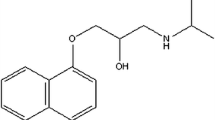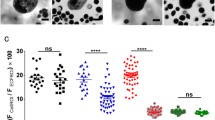Abstract
Normal platelet membranes were exposed in vitro to a variety of psychotropic medications commonly used in the treatment of patients with psychiatric disorders. Changes in structural order at the hydrocarbon region of the drug-exposed membranes were determined by steadystate fluorescence polarization measurements employing the fluorescent probe 1,6-diphenyl-1,3,5-hexatriene (DPH). Chlorpromazine, an aliphatic phenothiazine, produced a significant increase in DPH fluorescence polarization at concentrations from 2–200 μM. Thioridazine, a piperidine phenothiazine, and three piperazine derivatives, perphenazine, trifluoperazine, and fluphenazine, produced significant increases in this parameter at concentrations from 20–200 μM. The other agents tested, including thiothixene, lithium, antidepressants, anxiolytics, and anticonvulsants, were without effect in the concentration ranges examined. The phenothiazine-induced increase in DPH fluoresence polarization apparently depended on the structure of the phenothiazine nucleus; changes in side-chain structure appeared to modulate this effect, most likely by altering the inherent membrane solubility of the agents.
Similar content being viewed by others
References
Alivisatos SGS, Papastavrou C, Drouka-Liapati E, Molyvdas AP, Nikitopoulou G (1977) Enzymatic and electrophysiological changes in the function of membrane proteins by cholesterol. Biochem Biophys Res Commun 79:677–683
Belmaker RH, Lerer B, Klein E, Newman M, Dick E (1983) Clinical implications of research on the mechanism of action of lithium. Prog Neuropsychopharmacol Biol Psychiatry 7:287–296
Berridge MJ, Downes CP, Hanley MR (1982) Lithium amplifies agonist-dependent phosphatidylinositol responses in brain and salivary glands. Biochem J 206:587–595
Bickel MH, Garber BW, Moor M (1983) Distribution of chlorpromazine and imipramine in adipose and other tissues of rats. Life Sci 33:2025–2031
Boudet G, Levy-Toledano S, Maclouf J, Rendu F, Salesse R (1985) Change in the physical state of platelet plasma membranes upon ionophore A23187 activation. A fluorescence polarization study. Biochim Biophys Acta 812:243–248
Chin JH, Goldstein DB (1977) Effects of low concentrations of ethanol on the fluidity of spin-labelled erythrocyte and brain membranes. Mol Pharmacol 13:435–441
Cohen BM (1983) The clinical utility of plasma neuroleptic levels. In: Stancer HC (ed) Guidelines for the use of psychotropic drugs. Spectrum Publications, Jamaica, New York, pp 245–261
Cohen BM, Zubenko GS (1985) In vivo effects of psychotropic agents on the physical properties of cell membranes in the rat brain. Psychopharmacology, in press
Crews FT (1982) Effects of membrane fluidity on secretion and receptor stimulation. Psychopharmacol Bull 18:135–143
Crews FT, Majchrowicz E, Meeks R (1983) Changes in cortical synaptosomal plasma membrane fluidity and composition in ethanol-dependent rats. Psychopharmacology 81:208–213
Curry SH (1984) Clinical significance of neuroleptic plasma levels. In: Stancer HC (ed) Guidelines for the use of psychotropic drugs. Spectrum Publications, Jamaica, New York, pp 239–245
Despopoulos A (1970) Antihemolytic actions of tricyclic tranquilizers. Biochem Pharmacol 19:2907–2914
Dorus E, Cox NJ, Gibbons RD, Shaughnessey R, Pandey GN, Cloninger R (1983) Lithium ion transport and affective disorders within families of bipolar patients. Arch Gen Psychiatry 40:545–552
Farias RN, Bloj B, Morero RD, Sineriz F, Trucco RD (1975) Regulation of allosteric membrane-bound enzymes through changes in membrane lipid composition. Biochim Biophys Acta 415:231–251
Frenzel J, Arnold K, Nuhn P (1978) Calorimetric 13C NMR, and 31P NMR studies of the interaction of some phenothiazine derivatives with dipalmitoyl phosphatidylcholine model membranes. Biochim Biophys Acta 507:185–197
Hanski E, Levitzki A (1978) The absence of desensitization in the beta adrenergic receptors of turkey reticulocytes and erythrocytes and its possible origin. Life Sci 22:53–60
Harris RA, Schroeder F (1981) Ethanol and the physical properties of brain membranes: Fluorescence studies. Mol Pharmacol 20:128–137
Harris RA, Baxter DM, Mitchell MA, Hitzemann RJ (1984) Physical properties and lipid composition of brain membranes from ethanol tolerant-dependent mice. Mol Pharmacol 25:401–409
Heron DA, Hershkowitz M, Shinitzky M, Samuel D (1980a) The lipid fluidity of synaptic membranes and the binding of serotonin and opiate ligands. In: Ertlaner UZ, Dudai Y, Silman S, Teichberg VI, Vogel Z (eds) Neurotransmitters and their receptors. John Wiley and Sons, New York, pp
Heron DS, Shinitzky M, Hershowitz M, Samuel D (1980b) Lipid fluidity markedly modulates the binding of serotonin to mouse brain membranes. Proc Natl Acad Sci 77:7463–7467
Hirata F, Axelrod J (1980) Phospholipid methylation and biological-signal transmission. Science 209:1082–1090
Insel PA, Nirenberg P, Turnbull J, Shattil SJ (1978) Relationships between membrane cholesterol, alpha-adrenergic receptors, and platelet function. Biochemistry 17:5269–5274
Johnson DA, Lee NM, Cooke R, Loh HH (1979) Ethanol-induced fluidization of brain lipid bilayers: Required presence of cholesterol in membranes for the expression of tolerance. Mol Pharmacol 15:739–746
Kimelberg HK (1975) Alterations in phospholipid-dependent (Na+ +K+) ATPase activity due to lipid fluidity effects of cholesterol and Mg2+. Biochim Biophys Acta 413:143–156
Klein I, Moore L, Pastan I (1978) Effect of liposomes containing cholesterol on adenylate cyclase activity of cultured mammalian fibroblasts. Biochim Biophys Acta 506:42–53
Lakowicz JR (1983) Principles of fluoresence spectroscopy. Plenum New York
Loh H, Hitzemann RJ (1981) Synaptic membrane structure as a determinant of CNS drug actions and interactions. Q Rev Drug Metab Drug Interactions 3:155–194
Lyon RC, Goldstein DB (1983) Changes in synaptic membrane order associated with chronic ethanol treatment in mice. Mol Pharmacol 23:86–91
Mahju MA, Maickel RP (1969) Accumulation of phenothiazine tranquilizers in rat brain and plasma after repeated dosage. Biochem Pharmacol 18:2701–2710
Mavis RD, Vagelos PR (1972) The effect of phospholipid fatty acid composition on membrane enzymes in Escherichia coli. J Biol Chem 247:652–659
Ogiso T, Iwaki M, Mori K (1981) Fluidity of human erythrocyte membrane and effect of chlorpromazine on fluidity and phase separation of membrane. Biochim Biophys Acta 649:325–335
Perlman BJ, Goldstein DB (1984) Genetic influences on the central nervous system depressant and membrane-disordering actions of ethanol and sodium valproate. Mol Pharmacol 26:547–552
Post RM (1982) Use of the anticonvulsant carbamazepine in primary and secondary affective illness: Clinical and theoretical implications. Psychol Med 12:701–704
Pottell H, Van der Meer W, Herreman W (1983) Correlation between the order parameter and the steady-state fluorescence anisotropy of 1,6-diphenyl 1,3,5-hexatriene and an evaluation of membrane fluidity. Biochim Biophys Acta 730:181–186
Raiman R, Sechter D, Briley MS, Zarifian E, Langer SZ (1981) High-affinity 3H-imipramine binding in platelets from untreated depressed patients compared to healthy volunteers. Psychopharmacology 77:332–335
Rottenberg H, Waring A, Rubin E (1981) Tolerance and crosstolerance in chronic alcoholics: Reduced membrane binding of ethanol and other drugs. Science 213:583–585
Schreier S, Polnaszek CF, Smith ICP (1978) Spin labels in membranes: Problems in practice. Biochim Biophys Acta 515:375–436
Seeman P (1972) The membrane actions of anesthetics and tranquilizers. Pharmacol Rev 24:583–655
Seeman P (1977) Anti-schizophrenic drugs-Membrane receptor sites of action. Biochem Pharmacol 26:1741–1748
Sherman WR, Leavitt AL, Honchar MP, Hallcher LM, Phillips BE (1981) Evidence that lithium alters phosphoinositide metabolism: Chronic administration elevates primary d-myo-inositol-1-phosphate in cerebral cortex of the rat. J Neurochem 36:1947–1951
Shinitzky M, Barenholz Y (1978) Fluidity parameters of lipid regions determined by fluorescence polarization. Biochim Biophys Acta 515:367–394
Snedecor GW, Cochran WG (1980) Statistical methods, 7th ed. Iowa State University Press, Ames, IA, pp 1–507
Tarsy D, Baldessarini RJ (1976) The tardive dyskinesia syndrome. In: Klawans HL (ed) Clinical neuropharmacology, vol 1. Raven, New York
Ueno E, Kuriyama K (1981) Phospholipids and benzodiazepine recognition sites of brain synaptic membranes. Neuropharmacology 20:1169–1176
Van Blitterswijk WJ, Van Hoeven RP, Van der Meer MW (1981) Lipid structural order parameters (reciprocal of fluidity) in biomembranes derived from steady-state fluorescence polarization measurements. Biochim Biophys Acta 644:323–332
Whitkin JC, Gordon RK, Corwin LM, Simons ER (1982) The effect of vitamin E deficiency on some platelet membrane properties. J Lipid Res 23:276–282
Zimmer G (1984) Fluidity of cell membranes in the presence of some drugs and inhibitors. In: volume 12. Kates M, Manson LA (eds) Biomembranes. Plenum, New York, pp 169–203
Zubenko GS, Cohen BM (1984) In vitro effects of psychotropic agents on the microviscosity of platelet membranes. Psychopharmacology 84:289–292
Zubenko GS, Cohen BM (1985a) Biophysical alterations in cell membranes associated with psychotherapeutic drug exposure, psychopathology, and aging. Psychopharm Bull (in press)
Zubenko GS, Cohen BM (1985b) Effect of phenothiazine treatment of the physical properties of platelet membranes from psychiatric patients. Biol Psychiatry 20:384–396
Author information
Authors and Affiliations
Rights and permissions
About this article
Cite this article
Zubenko, G.S., Cohen, B.M. Effects of psychotropic agents on the physical properties of platelet membranes in vitro. Psychopharmacology 86, 369–373 (1985). https://doi.org/10.1007/BF00432231
Received:
Accepted:
Issue Date:
DOI: https://doi.org/10.1007/BF00432231




